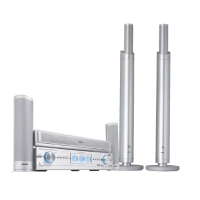Circuit-, IC descriptions and list of abbreviations
EN 135LX9000R 9.
The processing of audio is always done in stereo (e.g. separate
left- and right-channel) and the complete switching is realized
by using HEF4052, which is a dual four-to-one multiplexer. In
principle there are three independent selectors:
a) Scart 1-Output-Path:
Pos [7504] is used to select either Scart 2-Input (“AIN2L”/
”AIN2R”) or the signal directly from the audio DAC [7004]
(“ALDAC”/”ARDAC”) as the output source for Scart 1
(“AOUT1L”/”AOUT1R”).
The control is done by means of the lines “ASC1S” coming from
[7408] (IC [7408] acts as a port expander for the CC-P) and
“IASC1M”, which is directly coming from the CC. Pos [7412] is
used for level adaptation (3V3 to 5V) for the “IASC1M”-signal.
b) Scart 2-Output-Path:
Pos [7503] selects between Scart 1-Input (“AIN1L”/”AIN1R”),
signals from the internal frontend (“AFEL”/”AFER”) via MSP
[7600] or audio directly from the DAC [7004] (“ALDAC”/
”ARDAC”). The outputs of this switch are routed to Scart 2
(“AOUT2L”/AOUT2R”). This switch is controlled via “VSA1”-
and “VSA2”-line. These lines come from [7408] that is acting as
a port expander for the CC-P.
c) Record-Path:
Pos [7501] selects either signals from Scart 1 (“AIN1L”/
”AIN1R”) or Scart 2 (“AIN2L”/”AIN2R”) or Cinch-Front (“AINFL”/
”AINFR”) or the MSP [7600] (“AFEL”/”AFER”) and routes to the
audio ADC [7007] (“ALADC”/”ARADC”) for record purposes.
The switch is controlled via “RSA1”- and “RSA2”-signals.
These signals come from the MSP [7600], which acts as a port
expander of the CC-P. As there can also exist a fifth input in
case of DV-In is present the corresponding analog audio
signals from the DVIO-board are firstly routed via extra cable
and connector [1960] to the MSP. The MSP acts as a
preselector between audio from internal frontend or the DV-
Input.
Each of these three selectors ([7501], [7503] & [7504]) has a
separate Op-Amp on the output for level-adaptation-,
performance- and line-driving-reasons. [7505-A & -B] for
record, [7502-C & -D] for Scart 1-Output and [7502-A & -B]
respectively for Scart 2. Every audio output line on the two
Scart connectors can be “killed” (muted) by an extra transistors
([7506], [7508], [7509] &[7511]), which can be activated by the
“AKILL”-line. This signal is generated by the circuit around
[7404]/[7421] and is a combination of the “KILL”- from the CC-
P and the “IPFAIL” of the power-supply-unit.
d) Line-Out-Path:
see chapter 9.3.5
e) Digital Audio Output-Path without IOE-Print:
Additionally to analog audio the set is also equipped with a
digital output via cinch plug [1951]. The signal is generated on
the dig. board and routed via audio interface cable and
connector [1900] to the Ana-PCB. Here the “DAOUT”-line first
passes a 6-fold inverter [7580] being used as a driver and for
performance reasons (noise reduction, jitter, etc.). Afterwards
a transformer [5580] is necessary to achieve the correct level
and also to have a floating output with isolated ground before
the signal is fed via [3580] to cinch plug [1951]. The capacitor
[2580] performs an AC-coupling between connector- and set-
ground.
f) Digital Audio Output-Path with IOE-Print:
In case of usage of the IOE-print the digital audio signals (input
and output) are directly routed from digital board via interface
cable to plug [1920] on the IOE-print. The “DAOUT”-line is
splitted into two signals, one for cinch out and one for optical
out. The signal to cinch out first passes a 5-fold inverter [7250]
being used as a driver and for performance reasons (noise
reduction, jitter, etc.). Afterwards a transformer [5250] is
necessary to achieve the correct level and also to have a
floating output with isolated ground before the signal is fed via
[3259] to the cinch plug [1925] (or [1926-B] in case of option
“DIGITAL IN”). The capacitors [2256] and [2266] perform an
AC-coupling between connector- and set-ground. The second
“DAOUT”-signal is fed directly via [3264] to the optical out
transmitter [6255].
g) Digital Audio Input-Path with IOE-Print:
There are two possibilities for a digital audio input signal in case
of option “DIGITAL IN”. One is the signal from the optical
receiver [6259], which is routed via [3269] directly to plug
[1920]. The second is the signal from the cinch plug [1926-A].
This signal then passes an inverting amplifier [7250-6] and is
then routed via [2253] to the plug [1920].
9.3.4 Audio ADC/DAC
a) PCBs with AD1852 [7004]:
The conversion of analog audio signals from the record-
selector [7501] in the I/O (“ALADC”- & “ARADC”) is done via
UDA1361TS [7007]. This IC can process input signals up to
2Vrms by using external resistors [3047], [3053] in series to the
input pins. As the level from the DVIO-Board is only 1Vrms a
6dB step can be performed by setting pin 7 of [7007] to 3,3V via
[7008] and the “PWONSW”-line controlled by the CC-P to use
the whole dynamic range of the ADC. All required clock signals
are generated on the dig. board and only the audio data
(“A_DAT”-line) are routed from Ana- to Dig.-PCB for further
processing.
The transformation of dig. audio back into the analog domain is
done by AD1852 [7004]. All necessary clock signals are
coming from the dig. board and dig. audio data (“D_DATA0”-
line) are converted into analog signals, which are available at
pin 17/16 and pin 12/13 of [7004] as symmetrical signals.
Afterwards an Op-Amp. [7003] (line driver & converting to
unsymmetrical signal, gain = 1), which is also working as low-
pass-filter to increase signal performance (noise,
distortions,...), is passed. Then both signals (“ALDAC” &
“ARDAC”) are directly routed to the rear cinch output and also
used in the audio-I/O for further processing. The DAC has also
a mute possibility, which can be activated by setting pin 23 to
5V via [7001]. This mute is controlled either by the dig. board
(“D_IKLL”-line) or the “IPFAIL”-signal from power-supply-unit
(in this case it’s the combination of “A_KILL” and “IPFAIL”).
If the DAC is muted externally via pin 23 or if there are no audio
data available (e.g. “D_DATA0”-line zero), the output pins 8
and 22 of the DAC change to high (+ 5V). These two signals
are then combined with diode pos. 6006. After decoupling via
[7009] the signal “DAC_MUTE” is used as mute signal for the
mute transistors [7415], [7416] for cinch rear out.
b) PCBs with UDA1334BTS [7001]:
The conversion of analog audio signals from the record-
selector [7501] in the I/O (“ALADC”- & “ARADC”) is done via
UDA1361TS [7005]. This IC can process input signals up to
2Vrms by using external resistors [3039], [3041] in series to the
input pins. As the level from the DVIO-Board is only 1Vrms a
6dB step can be performed by setting pin 7 of [7005] to 3,3V via
[7006] and the “PWONSW”-line controlled by the CC-P to use
the whole dynamic range of the ADC. All required clock signals
are generated on the dig. board and only the audio data
(“A_DAT”-line) are routed from Ana- to Dig.-PCB for further
processing.
The transformation of dig. audio back into the analog domain is
done by UDA1334BTS [7001]. All necessary clock signals are
coming from the dig. board and dig. audio data (“D_DATA0”-
line) are converted into analog signals, which are available at
pin 14 and pin 16 of [7001]. Afterwards an Op-Amp. [7002] (line
driver & level adaptation, gain = 2) which is also working as
low-pass-filter to increase signal performance (noise,
distortions,...), is passed. Then both signals (“ALDAC” &
“ARDAC”) are directly routed to the rear cinch output and also
used in the audio-I/O for further processing. The DAC has also
a mute possibility, which can be activated by setting pin 8 to
3,3V via [7003]. This mute is controlled either by the dig. board

